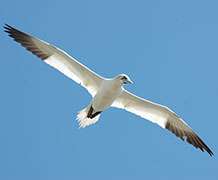Scientists unravel the mystery of gannets' feeding success

Researchers at Plymouth Marine Laboratory and the University of Exeter have combined two innovative technologies to probe the mystery of how seabirds locate food hotspots across vast tracts of ocean.
The way in which marine predators find food in what to us seems a largely featureless landscape, often tens or hundreds of kilometres from a 'home base', has long puzzled biologists.
For seabirds, such as gannets, the distance of journeys to and from foraging areas and hunting success is a finely balanced matter of life and death. Knowing where they find food is also crucial for their conservation. The advent of tiny data loggers carried by birds has provided important insights into where they feed, but less is known about the conditions they experience there.
A second, satellite-mounted, technology enables scientists to spot areas of the sea where two currents meet or upwelling occurs, commonly known as ocean fronts. They are often rich in nutrients, which encourages plankton growth, and are magnets for marine life, including fish which then become the prey of larger animals such as the Northern Gannet (Morus bassanus).
By bringing the two technologies together, the scientists have shown that the birds search out regions where fronts form most frequently, so making their foraging more efficient and less energetically costly.
Dr Steve Votier from the Environment & Sustainability Institute (ESI) at the University of Exeter who led the gannet research programme commented: "We have been studying gannet behaviour for nearly 10 years and have learnt much about what they do while at sea, but the key to this research was working with oceanographers. Using state-of-the-art satellite imagery they have enabled us to investigate how gannets forage at fronts – discontinuities in temperature and phytoplankton".
During the study, 66 gannets were tracked over two breeding seasons, revealing that the average foraging trip was around 178kms – with some travelling as far as 430kms in a single round trip.
The scientists, who brought together satellite observations of plankton abundance and sea surface temperature, were able to produce composite maps of front occurrence. Among other things, composite maps show those fronts that are more persistent, these being of much greater value to the predators.
Such established fronts are far more likely to have developed the complex food webs necessary to support top predators; temporary fronts may not last long enough to attract the fish which form the food of predators, such as gannets. Tracking showed where the birds visited, whilst the presence of the detected fronts provided a major part of the answer of what it was that drew them there.
Kylie Scales from Plymouth Marine Laboratory, who co-led the study as part of her PhD studies said: "Our studyhas demonstrated the importance of ocean fronts to flying predators. This technique, which we used in the Celtic Sea, can be used anywhere across the global ocean. It has great potential for identifying key feeding grounds for a wide range of predators – and that means it should become an indispensable tool in identifying conservation hotspots."
More information: Kylie L. Scales, Peter I. Miller, Clare B. Embling, Simon N. Ingram, Enrico Pirotta, and Stephen C. Votier. "Mesoscale fronts as foraging habitats: composite front mapping reveals oceanographic drivers of habitat use for a pelagic seabird." J. R. Soc. Interface November 6, 2014 11 100 20140679; dx.doi.org/10.1098/rsif.2014.0679
Provided by University of Exeter



















